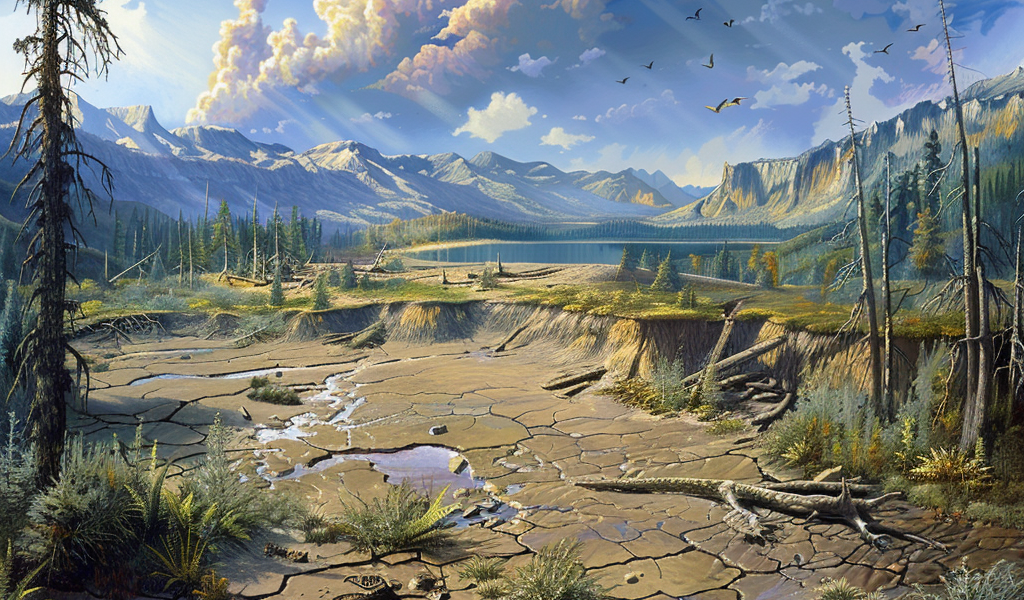Imagine a time on Earth approximately 233 million years ago, when the landscape was dramatically different from what we know today. A colossal landmass known as Pangea dominated the planet, surrounded by the expansive Panthalassa Ocean. This period, known as the Late Triassic, was characterized by a predominantly dry and arid climate, but a significant transformation was on the horizon. This transformation was precipitated by a climatic event that lasted for an astonishing one million years, known as the Carnian Pluvial Episode (CPE).
Recent research conducted by an international team of scientists has shed light on this critical period in Earth’s history, revealing how it facilitated the rise of dinosaurs as the dominant terrestrial animals. Key contributors to this research include Dr. Jacopo Dal Corso from the China University of Geosciences and Professor Mike Benton from the University of Bristol. Their collaborative efforts have uncovered vital evidence of this extinction event and its profound impact on life on Earth.
The Carnian Pluvial Episode
The Carnian Pluvial Episode marked a significant shift in the climate of Pangea. Initially, the interior of this supercontinent was largely arid, with rainfall primarily concentrated along coastal areas. However, geologists Schlager and Schollnberger made a groundbreaking discovery in the 1970s in Austria’s Northern Limestone Alps. They found a layer of dark gray rock that indicated wet conditions sandwiched between periods of dryness, suggesting a global climate event that would later be identified as the CPE.
The question arises: what triggered this dramatic change in climate? The evidence points to massive volcanic eruptions that occurred in the Wrangellia Province, an area that today encompasses parts of Alaska and British Columbia. These eruptions released vast amounts of carbon dioxide into the atmosphere, significantly altering the planet’s climate.
“The eruptions peaked in the Carnian,” explains Dr. Jacopo Dal Corso. “They were so immense that they pumped enormous quantities of greenhouse gases like carbon dioxide into the atmosphere, leading to spikes in global temperatures.”
Mass Extinction and the Dawn of New Life
The influx of greenhouse gases resulted in a rise in global temperatures by approximately 5 to 7 degrees Fahrenheit. This increase in temperature caused enhanced evaporation from the oceans, leading to a surge in rainfall across the globe. However, this climatic upheaval did not come without consequences. The rapid environmental changes triggered a significant loss of biodiversity, as many species struggled to adapt to the new conditions.
Despite the devastation, nature has a remarkable ability to adapt. As many species faced extinction, new ones began to emerge, filling the ecological niches left vacant. This led to the formation of ecosystems that began to resemble those we see today.
“The new floras probably provided slim pickings for the surviving herbivorous reptiles,” notes Professor Mike Benton. “We now know that dinosaurs originated some 20 million years before this event, but they remained quite rare and unimportant until the Carnian Pluvial Episode hit. It was the sudden arid conditions after the humid episode that gave dinosaurs their chance.”
The Rise of Dinosaurs
As the climate evolved from the humid conditions of the CPE to drier periods, dinosaurs began to thrive. The environmental shifts created opportunities for these early reptiles, allowing them to adapt and diversify. This period marked the beginning of the age of dinosaurs, which would dominate the Earth for millions of years to come.
The Carnian Pluvial Episode serves as a reminder of the intricate connections between climate, extinction, and evolution. As scientists continue to study this pivotal moment in Earth’s history, they gain valuable insights into how life on our planet has been shaped over millions of years.
Implications for Modern Climate Change
The findings surrounding the Carnian Pluvial Episode also hold significant implications for our understanding of modern climate change. The volcanic activity that triggered this ancient climatic event parallels some of the challenges faced today as greenhouse gas emissions rise due to human activities. Understanding the past can provide critical insights into the potential consequences of current environmental changes.
As researchers delve deeper into the mysteries of the Carnian Pluvial Episode, it becomes increasingly clear that the lessons learned from this ancient period are relevant to our current ecological challenges. The rise and fall of species during this time illustrate the fragility of ecosystems and the importance of biodiversity in maintaining a balanced environment.
In summary, the Carnian Pluvial Episode represents a crucial chapter in the history of our planet, one that not only reshaped the course of life on Earth but also offers vital lessons for the future. The research conducted by Dr. Dal Corso, Professor Benton, and their colleagues continues to illuminate the complexities of our planet’s climatic past and its implications for the present and future.





